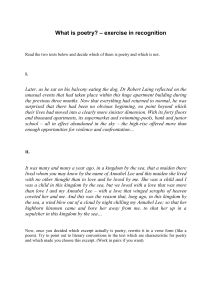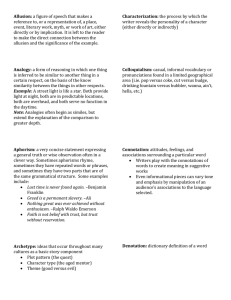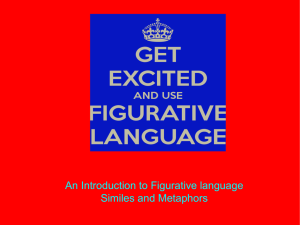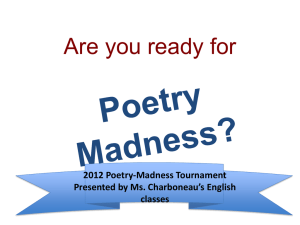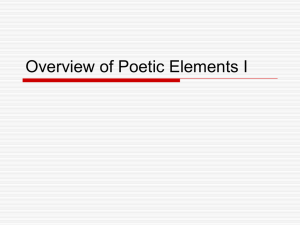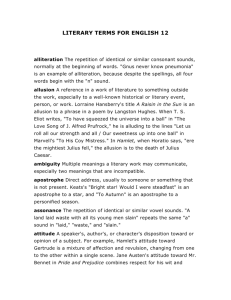Poetry Terms: Explication, Metaphor, Simile & More
advertisement
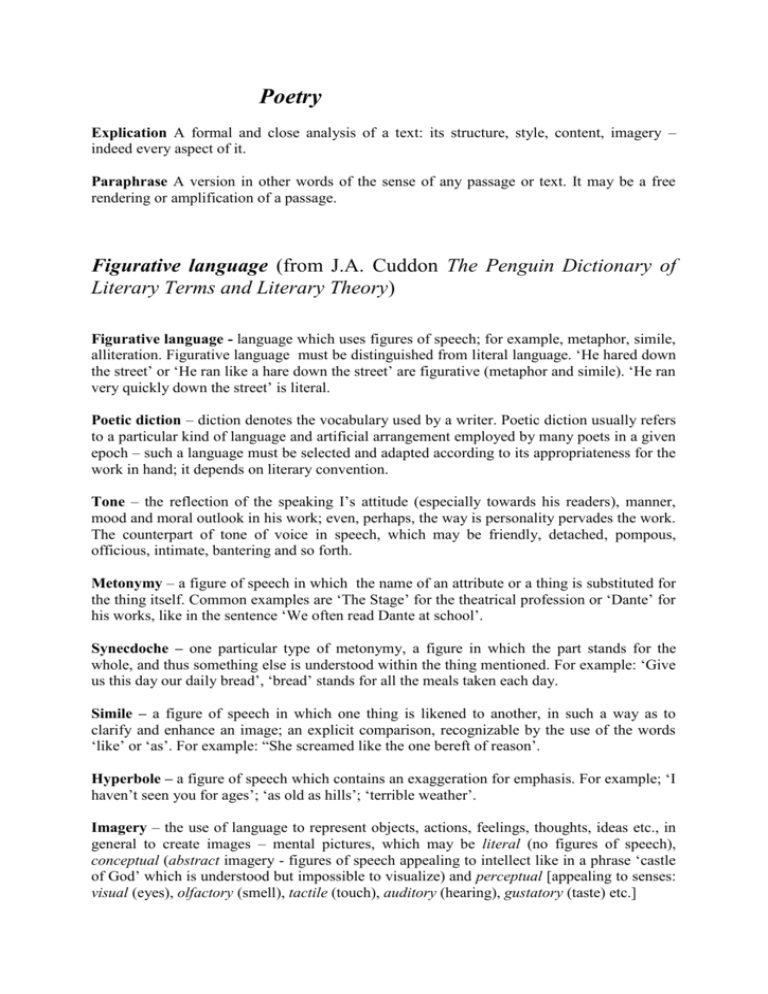
Poetry Explication A formal and close analysis of a text: its structure, style, content, imagery – indeed every aspect of it. Paraphrase A version in other words of the sense of any passage or text. It may be a free rendering or amplification of a passage. Figurative language (from J.A. Cuddon The Penguin Dictionary of Literary Terms and Literary Theory) Figurative language - language which uses figures of speech; for example, metaphor, simile, alliteration. Figurative language must be distinguished from literal language. ‘He hared down the street’ or ‘He ran like a hare down the street’ are figurative (metaphor and simile). ‘He ran very quickly down the street’ is literal. Poetic diction – diction denotes the vocabulary used by a writer. Poetic diction usually refers to a particular kind of language and artificial arrangement employed by many poets in a given epoch – such a language must be selected and adapted according to its appropriateness for the work in hand; it depends on literary convention. Tone – the reflection of the speaking I’s attitude (especially towards his readers), manner, mood and moral outlook in his work; even, perhaps, the way is personality pervades the work. The counterpart of tone of voice in speech, which may be friendly, detached, pompous, officious, intimate, bantering and so forth. Metonymy – a figure of speech in which the name of an attribute or a thing is substituted for the thing itself. Common examples are ‘The Stage’ for the theatrical profession or ‘Dante’ for his works, like in the sentence ‘We often read Dante at school’. Synecdoche – one particular type of metonymy, a figure in which the part stands for the whole, and thus something else is understood within the thing mentioned. For example: ‘Give us this day our daily bread’, ‘bread’ stands for all the meals taken each day. Simile – a figure of speech in which one thing is likened to another, in such a way as to clarify and enhance an image; an explicit comparison, recognizable by the use of the words ‘like’ or ‘as’. For example: “She screamed like the one bereft of reason’. Hyperbole – a figure of speech which contains an exaggeration for emphasis. For example; ‘I haven’t seen you for ages’; ‘as old as hills’; ‘terrible weather’. Imagery – the use of language to represent objects, actions, feelings, thoughts, ideas etc., in general to create images – mental pictures, which may be literal (no figures of speech), conceptual (abstract imagery - figures of speech appealing to intellect like in a phrase ‘castle of God’ which is understood but impossible to visualize) and perceptual [appealing to senses: visual (eyes), olfactory (smell), tactile (touch), auditory (hearing), gustatory (taste) etc.] Rhetorical figures – artful arrangements of words to achieve a particular emphasis and effect; a rhetorical figure does not alter the meanings of words (contradictory to for example metaphor). Best known rhetorical figures are: rhetorical question (not expecting any answer, self-evident, used for artistic effect); rhetorical irony (the attitude and tone of the speaking I is the exact opposite to what is expressed), alliteration (in which consonants at the beginnings of stressed syllables are repeated); assonance (repetition of similar vowel sounds, usually close together); consonance (the close repetition of identical consonant sons before and after different vowels); onomatopoeia (the formation and use of words to imitate sounds, the sound reflects the sense); anaphora (the repetition of a word or a group of words in successive clauses , usually in the beginning of each verse of a poem); apostrophe (in which a thing, a place, an abstract quality, an idea, a dead or abstract person, is addressed as if present and capable of understanding). Metaphor – a figure of speech in which one thing is implicitly described in terms of another, it consists of ‘tenor’ (the drift of thought regarding the subject of a metaphor); and ‘vehicle’ (the image which embodies the tenor); e.g. in ‘she is the sunshine of my life’ the sunshine is the vehicle while the tenor is ‘her’ brightness, warmth, love etc, the speaking I wants to express. Lyrical genres Sonnet consists of 14 lines usually in iambic pentameters with considerable variations in rhyme scheme. Often written in cycle – a series of sonnet on a particular theme to a particular individual. Love is the commonest theme. Ode – a lyric poem of some length. The main features are an elaborate stanza-structure, a marked formality and stateliness in tone and style (which make it ceremonious), and lofty sentiments and thoughts. In short, an ode is rather a grand poem; a full-dress poem. However, this said, we can distinguish two basic kinds: the public and the private. The public is used for ceremonial occasions, like funerals, birthdays, state events, the private often celebrates rather intense, personal and subjective occasions; it is inclined to be meditative, reflective. Elegy – in classical literature the subjects of elegies were various: death, war, love etc, the elegy was used also for epitaphs and commemorative verses, and very often signified mourning. However it is only since 16th century that an elegy has come to mean a poem of mourning for an individual or a lament for some tragic event. Lyric – a fairly short poem, not often longer than fifty or sixty lines, and often much shorter, and it usually expresses the feelings and thoughts of a single speaker (not necessarily the poet himself) in a personal and subjective fashion. The range and variety of lyric verse is immense, and lyric poetry, which is to be found in most literatures, comprises the bulk of all poetry. Free verse has no regular meter or line length and depends on natural speech rhythms and the counterpoint of stressed and unstressed syllables. In the hands of a gifted poet it can acquire rhythms and melodies of its own.

